LG UP8000 Reviewed at $599.00 (55")
Product Name: LG UP8000
Product Description: 2021 4K UHD LCD TV
-
Design - 9/10
9/10
-
Video Quality - 7.9/10
7.9/10
-
Ports & Connectivity - 8.7/10
8.7/10
-
OS, Apps and Features - 9.3/10
9.3/10
-
Price / Quality - 9/10
9/10
Summary
Reviewed at $599.00 (55″)
Pros
- Nice viewing angles
- Extremely low input lag
- Slim design
- webOS 6.0
Cons
- HDR is average
- Sub-par contrast
- No wide color gamut
- No HDMI 2.1
Cheapest Places to Buy :
*We are a reader-supported website. When you buy through links on our site, we may earn a small affiliate commission at no extra cost to you. Home Media Entertainment does not accept money for reviews.*
For one more year we saw LG offering a staggering amount of new releases and with the arrival of the new mini LED it resulted in a much bigger and more diverse lineup than ever before. But while many will be drooling for one more year over the top OLEDs and QNEDs there is a huge portion of the consumer market that have low requirements and will certainly be looking at the lower tiers of what LG will be offering. And as such today in our LG UP8000 review we will be looking at this low cost TV that belongs in the lower tier 4K UHD series.

Although the UHD series makes a comeback from last year the UP8000 is not a direct replacement of any of the units belonging in that category. Taking a closer look it seems that the UP8000 is an amalgamation of 2020’s UN8500 and UN7300 as it borrows some specs and features from both of them. This probably has to do with the fact that the arrival of the new QNEDs made LG change the specs of their lower tier models in order to fit them better in their entire lineup this year.
So what does the UP8000 bring to the table? Well LG has tried to mix us a lot with this model as different sizes seem to have different specs. For start the unit comes with an ADS panel except for the 50″ and 60″ that use VA panels instead. All of them use a Direct LED backlight system with local dimming while their refresh rate is 50/60 Hz (depending on the market) except from the 82″ and 86″ sizes that come with 100/120Hz refresh rates. Also these two sizes are the only ones that feature the new α7 Gen4 Processor 4K as all the other ones have to settle with a quad core processor instead.
Lastly the 82″ and 86″ are the only UHD models that still come with HDMI 2.1 ports as all the other sizes and models in the series use the older HDMI 2.0. Keep in mind that the UP8000 is missing Dolby Vision but at least it comes with the new webOS 6.0. So now that we have gone through a fast review over its specs let’s see if it is a worthy and valuable addition to LG’s lineup this year.
Design
Although in terms of specs the UP8000 sits somewhere in between the UN8500 and UN7300 when it comes to its design the UP8000 uses a different shell than those two. Obviously these TVs being in the same category meant that changes are subtle but it was obvious that LG didn’t reuse the same design the 2020 models had.
One are where the difference was more than obvious was the TV’s thickness as the new UP8000 is more slim than any previous UHD TV from LG. As such this one measured just 2.5″ (6.4 cm) which is almost a 30% reduction in thickness making it look great when mounted on a wall. Usually such slim designs we see in at least some middle tier models so it’s nice to see such a low cost unit featuring such a nice design.
The unit feature a bit better borders that don’t protrude as much as last year’s models making the screen look a bit better than before. Turning the TV around we find a fairly plain design with all the connectors being separated into two groups and positioned on the right side with the power connector being the only one kept separately on the left. The layout is pretty similar to the UN8500 and UN7300 but they don’t use the same plastic shell as there are minor differences here and there.

One thing that was very much missing last year from both the UN8500 and UN7300 was any kind of cable management as both models had no grooves to drive your cables whatsoever. Although this haven’t changed in the UP8000 at least LG provides in both lower corners, just above the feet, some short of plastic hooks and you can keep all your cables together this way.
As for the stand once again the UP8000 follows a very similar but not entirely the same design as the UN8500 and UN7300. The TV is using a standard bench type stand with the two legs locked in place at the very edges of the TV which may be good for stability but certainly will require a bigger furniture for you to place it on. The legs are made out of metal which is a small improvement over last year’s plastic ones. But on the other side they lack any kind of cable management to help drive the cables through the back so the available hooks above them is the only thing that can keep the cables together.
And while the TV design is in line with most lower tier releases we are happy to see that LG provides with it their new redesigned Magic Remote code named MR21. The new Magic Remote 2021 seems to bring some fresh changes that go with the new trends in 2021. Not that the old Magic Remote was bad but after some years it really needed some upgrading. Most functions remain the same with LG’s unique pointer system, the same universal remote functionality and smart features.
What is different is the looks and to be honest we like the new one better while it seems LG decided to lower the number of available buttons but at the same time increase the dedicated ones. While before we had buttons only for Netflix and Amazon Prime now we also get Disney+, LG channels along with special buttons for both voice assistants. Also dedicated playback buttons are a thing of the past. The new Magic Remote may seem different but the changes are welcome ones and they don’t affect the overall usefulness or functionality of the remote.

For a TV that belongs in LG’s lowest tier of releases the UP8000 left us with very good impressions. Build quality was the standard for this price but the TV’s much better thickness along with the new redesigned Magic Remote certainly add a few points.
Video Quality
Processor technology used
As with last year, LG is using three different processors for powering their 2021 TVs with the top OLEDs, top QNEDs and a couple of the NanoCells getting the 4th generation of a9 processor, most middle tier releases get the a7 Gen4 AI processor and only the lower tier NanoCells and all UHD TVs come with a low capability quad core processor.
As always details on these processors are slim and the quad core processor found in the UP8000 doesn’t give us any indication of its capabilities other than some generic marketing material from LG.
Obviously we are loosing the AI capabilities we saw in the a7 and a9 processors that LG has been advertising so aggressively meaning that AI up-scaling capabilities are more limited here. The processor supports noise reduction along with creating more vibrant colors and better contrast.
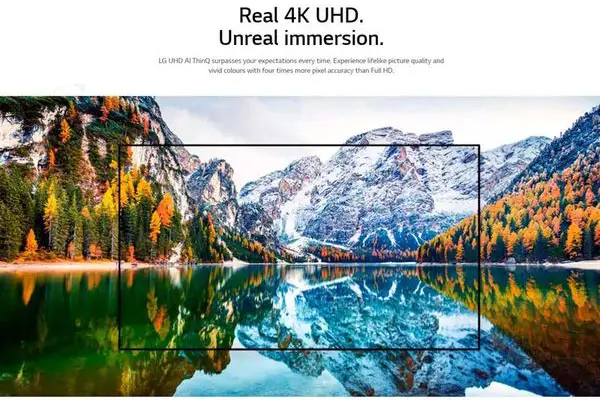
For this part of our review we did try several different source videos in multiple resolutions from low SD content and broadcasting material all the way up to 720p, 1080p and 4K resolution and from what we saw the UP8000 did process the original content pretty good. Up-scaling of images didn’t reveal any noticeable artifacts and the overall image was satisfactory but heavily dependent on the original content quality.
Due to the less capable processor the TV is also losing some of the more advanced audio capabilities that we saw recently in our LG C1 review so what we get here is a more basic audio feature set which was to be expected.
One thing that should be noted is that the 82″ and 86″ sizes comes with the much better α7 Gen4 Processor 4K which obviously means better AI upscaling, better image processing and more advanced audio capabilities. Unfortunately we couldn’t test these sizes ourselves in order to have a better idea of the differences between the two variants of the same model.
Lighting technology used
When it comes to the lighting system used what we get is a Direct LED system with no Local Dimming. And this is a common characteristic we see in low cost TVs as LG has reserved their mini LED, FALD and Edge LED light systems only for the medium and high tier models.
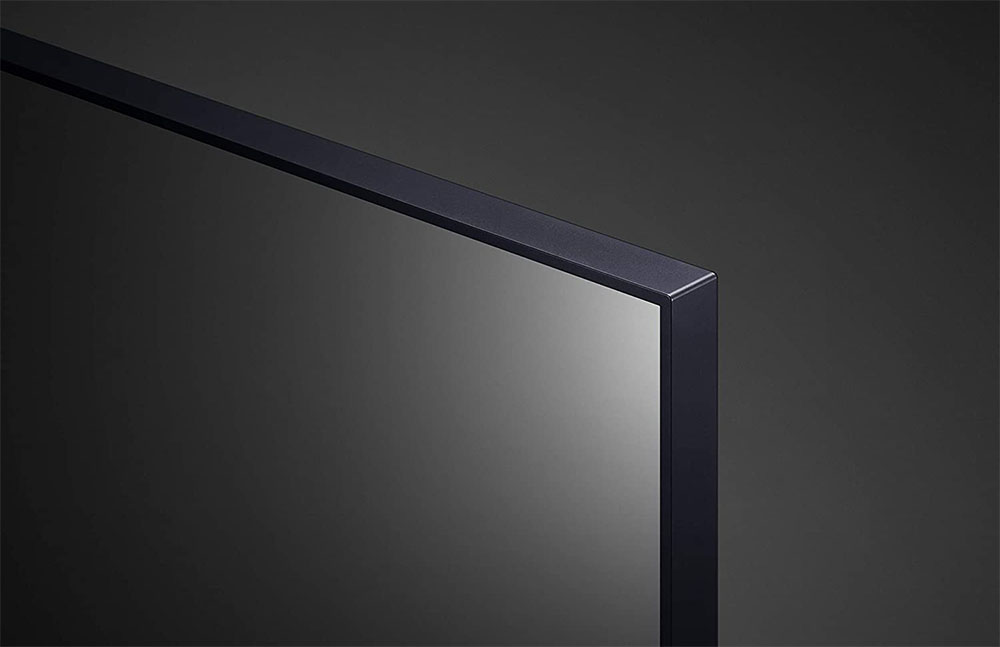
The Direct LED system is using light behind the included ADS panel but is much less capable than a mini LED or FALD system which means far less brightness output, less light accuracy and lower contrast which means that blacks will appear more greyish than true blacks. And with the UP8000’s ADS panel low contrast capabilities the omission of Local Dimming makes things even worse.
We were not expecting much here as having a Direct LED system is pretty common the last few years in the lower end category and in line with what we have seen in many other TVs with a similar price. At least having an IPS-like panel in combination with the Direct LED light system makes the UP8000 less prone to any major burn-in problems.
Brightness / Contrast
One of the most important aspects of a HDR TV, but not the only one, is brightness output. Usually in these low budget categories the kind of performance we see is less than stellar and most of the times the brightness capabilities of these units are not enough to make HDR justice even if these are advertised as HDR TVs which couldn’t be more far from the truth.
As for the UP8000 it seems that without any calibration the Expert (Dark Room) mode is the most accurate one and this is what we used to test the SDR brightness over a 10% window which gave us a measurement of 281 nits. As for the HDR brightness test over a 10% window gave us 323 nits of brightness by using the Cinema mode.

From the numbers we see here we can say that the UP8000 fares somewhere between the UN8500 and the UN7300. Last year the UN7300 was a bit of an odd one as it managed to outperform the theoretically better UN8500 but the UP8000 this year seems to perform somewhere between the two indicating what we said before. That this unit seems to borrow elements from both 2020’s models.
Overall brightness for the UP8000 is not good at all. For SDR content this is not a big deal but when it comes to HDR material the TV is not bright enough to make HDR any justice. This may be advertised as an HDR model but it is only by name. If you don’t care much about HDR then you shouldn’t worry but if you at least want to have a basic HDR experience you will need to go to a higher category.
Also we shouldn’t forget to talk about its contrast performance which unfortunately is not good at all. And this stems from the fact that it’s using an IPS-like panel and all TVs that use such technology suffer from mediocre contrast performance. This means that blacks are not very deep and look more greyish especially if you watch in low lit or completely dark environments.
We don’t know the reason for this but for the 50″and 60″ sizes LG opted for a VA panel instead and this surely will have a positive outcome when it comes to these models contrast performance. We couldn’t see these for ourselves as the testing unit we have is a 55″ size but it’s typical for VA panels to have much better contrast than IPS and ADS ones.
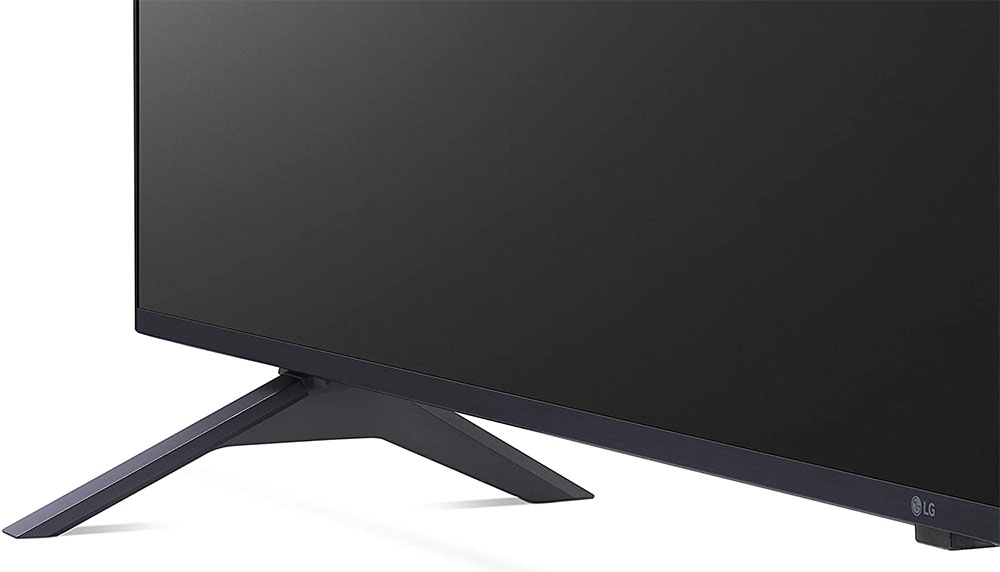
Viewing angles
The UP8000 is using an ADS panel and this usually means good things in terms of viewing angles. It cannot reach the extreme angles of OLED technology but IPS-like panels perform far better than any VA ones will ever be capable of.
For the unit we tested specifically we would say that a maximum of 30-35 degrees is the best you can get as anything more and the color accuracy, brightness and black levels take a major hit to remain watchable.
The TV is lacking any kind of wide viewing angle technology that we see in some of the top tier models but for its class it fares pretty good to be used as a family TV. Keep in mind that the 50″ and 60″ sizes are using VA panels and this means that viewing angles in that size will be much worse than what we have seen here.
Overall if you consider the UP8000 for family usage or plan to watch from angles other than the sweet spot then this one can be considered a good low cost option.
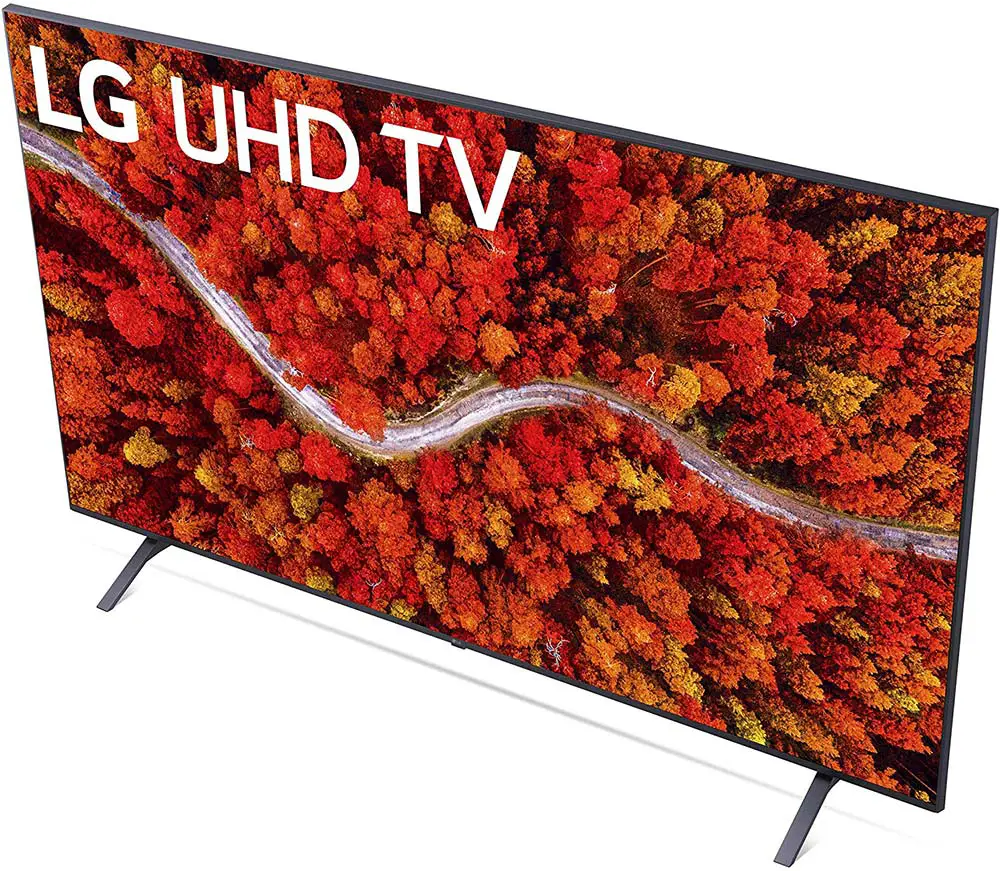
HDR support
As far as HDR support the UP8000 gets only the basics like the UN7300 the year before. LG has stripped Dolby Vision from their 4K UHD series and all models get only the basic HDR10 that is required for 4K UHD playback along with HLG that is used mainly for broadcasting.
And along with Dolby Vision, gone is also the feature we saw in the LG C1 called Dolby Vision IQ that could automatically adjust the Dolby Vision dynamic tone mapping according to the ambient light in the room. No reason obviously to have that since Dolby Vision is completely absent.
And while Dolby Vision has been stripped for cost reasons, HDR10+ is completely MIA from all LG TVs and we don’t see them supporting it in the near future at least with LGs strong support of Dolby Vision and the rivalry they have with Samsung on the HDR front.
Color coverage
Another characteristic we see in these budget TVs is the lower color coverage they can achieve. And while manufacturers don’t directly mention it usually these TVs cannot display wide color gamut that is essential for 4K HDR viewing. And this is another grey area on these so called HDR TV sets as they may be able to display HDR but without wide color gamut they shouldn’t be considered true HDR TVs.

The UP8000 gave us a color coverage of 79% of the DCI-P3 color space which is sub-par even for a low performing TV like this. And this seemed to be consistent as on the wider REC.2020 color space as we got a 58% coverage which is again very low by any standards.
From what we see here the UP8000 managed to perform worse than both the UN8500 and the UN7300 from last year and this is very disappointing as the UP8000 is considered the best non NanoCell unit LG has to offer but it failed to reach the same standards even its predecessors had set.
Motion performance
Next is our motion performance tests and from what we saw the UP8000 is using a 50 Hz (or 60 Hz depending on your region) panel along with a 120 Hz backlight dimming frequency. The 82″ and 86″ sizes seem to go for a 100/120Hz frequency panel instead so surely these two will perform better than the rest of the sizes.
The TV comes with the standard Motion Interpolation in order to smooth out motion and can be enabled from the TruMotion setting and by adjusting the De-judder slider. In contrary to higher tier models the UP8000 doesn’t have the second De-blur slider showing the limited capabilities we get here. Enabling Motion Interpolation can give you satisfactory results but when there are busy scenes with a lot of camera movements the TV fails to interpolate correctly and motion artifacts do become visible.
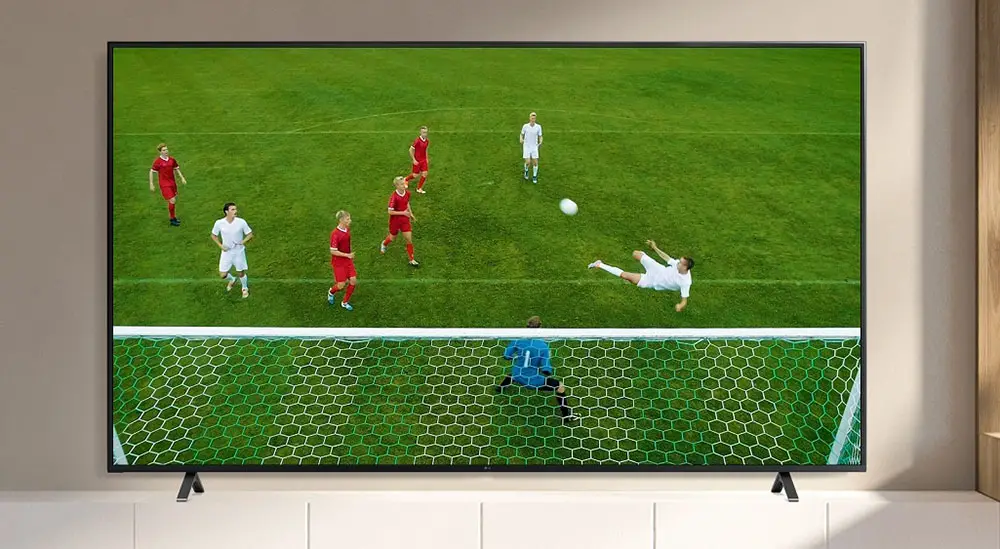
There is no Black Frame Insertion (BFI) available here so the standard Motion Interpolation through the TruMotion setting is your only bet for improving somewhat the motion in case you find its performance very distracting. Also keep in mind that the UP8000 doesn’t have any kind of VRR support either it be HDMI Forum VRR, FreeSync or G-Sync which is a bit disappointing but not unexpected in this price. If you are a gamer and would like to have these then you should definitely look for a higher tier TV than this.
In general the UP8000 behaved very similarly to what we had seen in the UN7300. Both in terms of features, capabilities and options the UP8000 displayed the same weaknesses we saw before.
Input lag
If there is one area where it seems that all manufacturers have managed to excel the last few years is at bringing the input lag of their models to such low levels that it cannot be considered a problem with TVs anymore. Some TVs have even reached single digits here and while they may still not be as low as gaming monitors the numbers we see can be considered satisfactory even by hardcore gamers standards.
By enabling the Game mode on the UP8000 we were able to get an average of 10.3 ms of input lag which was consistent in both 1080p and 4K resolutions and we consider it excellent by any standards. If you turn Game mode off the input lag spikes to 117 ms which may seem high but still remains highly playable especially for games that are slower and don’t require fast response times.

The TV also comes with Auto Low Latency Mode (ALLM) which is a feature that can be used with devices that also support that like gaming consoles as both the PS5 and Xbox and can really benefit their users. You can enable ALLM by using the Game Optimizer. Once again we get HGiG Mode which is HDR Gaming Interest Group’s technology that ensures you enjoy HDR games the way that their creators and developers intended.
For this review we connected our PS5 and used our just delivered copy of F1 2021 for a spin. The UP8000 may not impress with its image properties but when it comes to its response times we have nothing bad to say. Each button press would register instantly on screen and if you are using the Game mode then even the most demanding games will render crazy fast.
In general the UP8000 may be missing a few game centric features but considering its extremely low input lag it can be ideal for those looking for a low cost gaming TV.
Image quality impressions
We were expecting the UP8000 to perform somewhere in between last year’s UN8500 and UN7300 and in many cases this was indeed what we got. But there were a few aspects of this model that fared even worse than both of last year’s models which is probably a result of the introduction of the new QNED TVs.
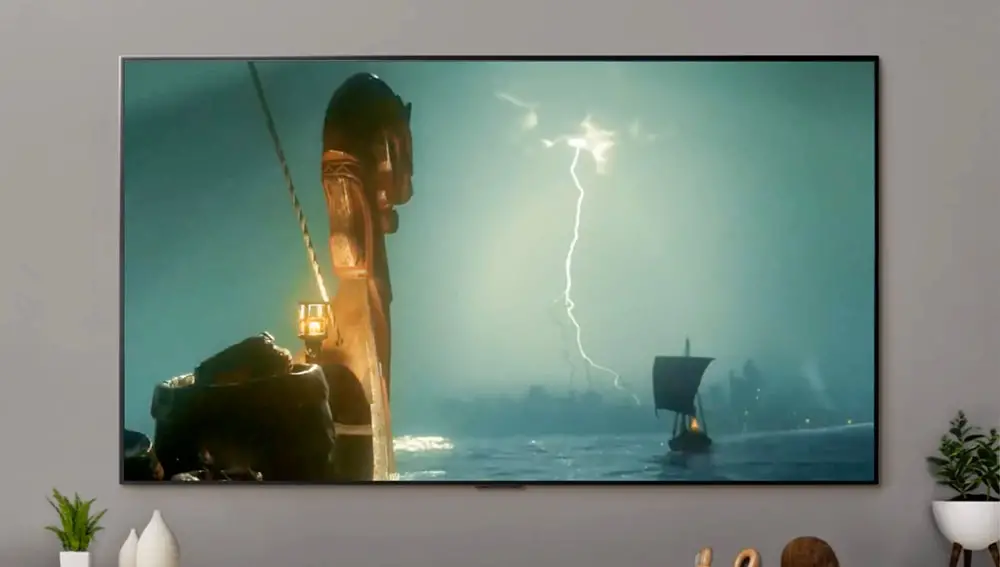
You see, with the arrival of the new series LG decided to keep all their previous lineup including both the NanoCells and the UHD TVs. This meant that at least for the UHD series their performance would further be affected by the introduction of more models in LG’s lineup. In many cases the UP8000 kept the same performance or something between the two 2020 models but in some other cases it failed to do.
Also keep in mind that different sizes have different panels, native refresh rates and processors meaning vastly different performance in some cases so it is not easy to judge the UP8000 as a whole. What we wrote here is specifically mentioned for the 55″ and we can talk only about this one with certainty.
Even with the usage of a simple quad core processor the UP8000 had good up-scaling capabilities in most material used. The ADS panel used showcased good viewing angles perfect for family usage while its low input lag makes this one for an excellent low cost gaming TV. The inclusion of Filmmaker and HGiG modes is considered a plus even though the image capabilities of the TV cannot take full advantage of what these picture modes can offer.
On the other hand having a less capable Direct LED light system resulted in the TV having less than stellar brightness output while using an ADS panel in combination with no Local Dimming resulted in contrast being mediocre at best with blacks appearing more like greys. Color coverage was not so good with the TV failing to display even what last year’s models did while motion performance can be described as average. Lastly the TV does not support Dolby Vision at all.
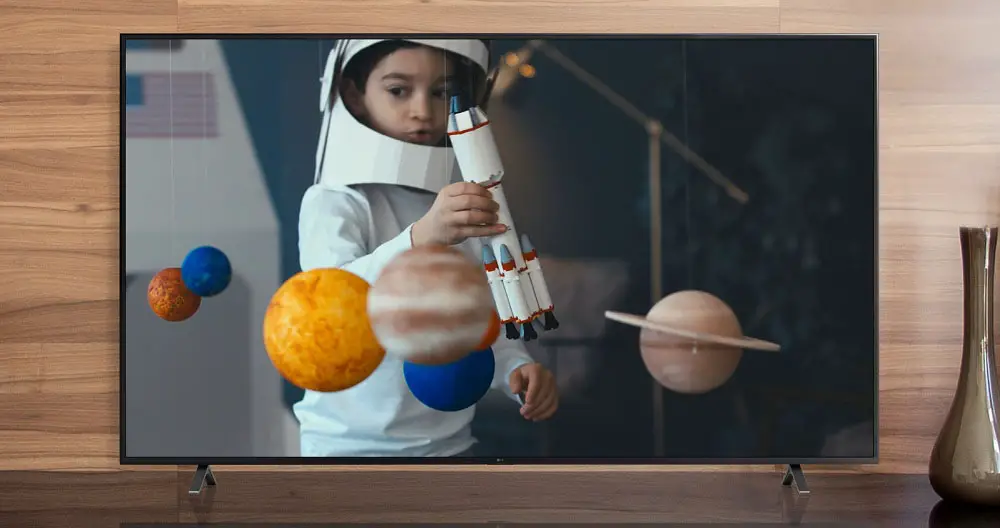
We are a bit disappointed with the UP8000 to be honest. While it did manage to perform as we were expecting in some tests, there were a few where it did worse and this can be considered a downgrade no matter how you see it. In the end this may be a HDR TV but in reality this is only by name.
Audio Quality
Next in line is sound performance and from what we see the UP8000 features a pretty standard 2.0 channels audio system with a total of 20 watts of power which is the normal for this category. The included system is adequate for casual viewing but in general it cannot offer anywhere near the kind of immersion of a surround system. From what we heard and comparing its feature set the TV is completely similar to last year’s UHD models.
The TV comes with a couple of audio features with one being Ultra Surround which is a technology which seeks to eliminate the distorted sound, providing a greater range of audio with the use of algorithms that are responsible for sending the sound in different directions looking to create a similar sensation that can be found in a movie theater.
Another feature we find is called AI Sound and this is a simpler version of the AI Sound Pro technology that we saw in the LG C1 and is responsible for up-mixing legacy audio into virtual 5.1 surround sound. Lastly we get the AI Acoustic Tuning system which the TV uses along with the help of the Magic Remote’s microphone in order to adjust the audio settings accordingly and provide the best possible result. Think of this similar to the automatic calibration systems we find in almost all AV receivers but in a more simple form.
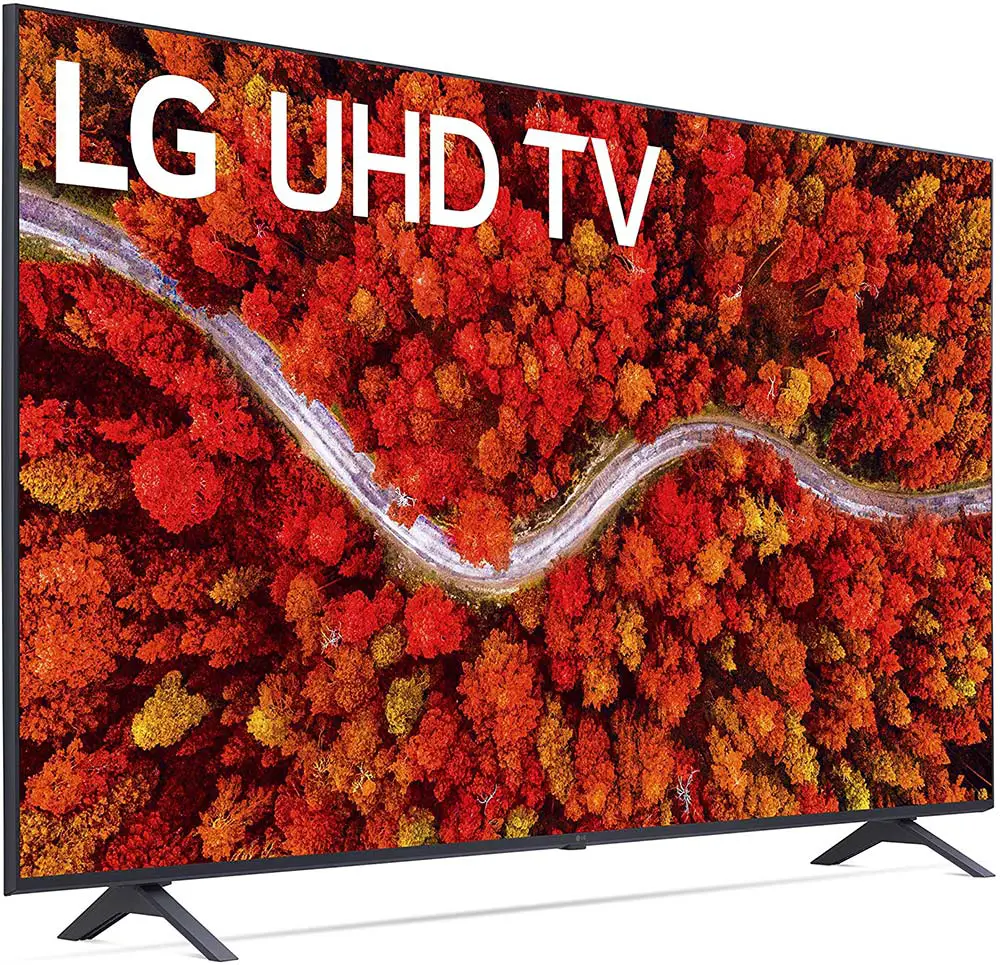
Lastly the TV is Bluetooth Surround Ready which is a feature first introduced in 2020 LG TVs and with this you can use the built-in Bluetooth to connect rear speakers to the TV. But keep in mind that by adding a couple of rear speakers doesn’t mean that you can have a true 5.1 channels audio system as the TV will use only a legacy stereo track and up-mix it to all the available speakers along with the rear Bluetooth ones. As a result the surround effect is not as good or precise as you would expect but certainly is slightly better than the simple two front channels.
After LG dropping support for DTS last year it seems that this is going to be a permanent thing as the UP8000 along with the entire LG lineup has no DTS support whatsoever which is really disappointing to be honest even if Dolby audio is the prevalent format these days. At least with the inclusion of eARC you can pass-through Dolby Atmos to an external audio device.
The TV cannot do anything more than the basics. If you are hoping for some cinematic immersion you will be disappointed. It can get loud and output pretty distinct dialogue and sound effects but everything feels shallow and it can be considered ideal only for casual use. If you want anything better we would suggest you to at least buy a soundbar that can do much better than what the TV can offer.
Ports and Connectivity
Moving on to our next section let’s see what kind of connectivity options we get here. The UP8000 follows the same layout we have seen in some of the other lower tier units and has two groups of ports on the right side of the back panel with one looking sideways and is easier to use when the TV is wall mounted while the second one look backwards and can be used mostly if you plan to place the TV on a furniture.
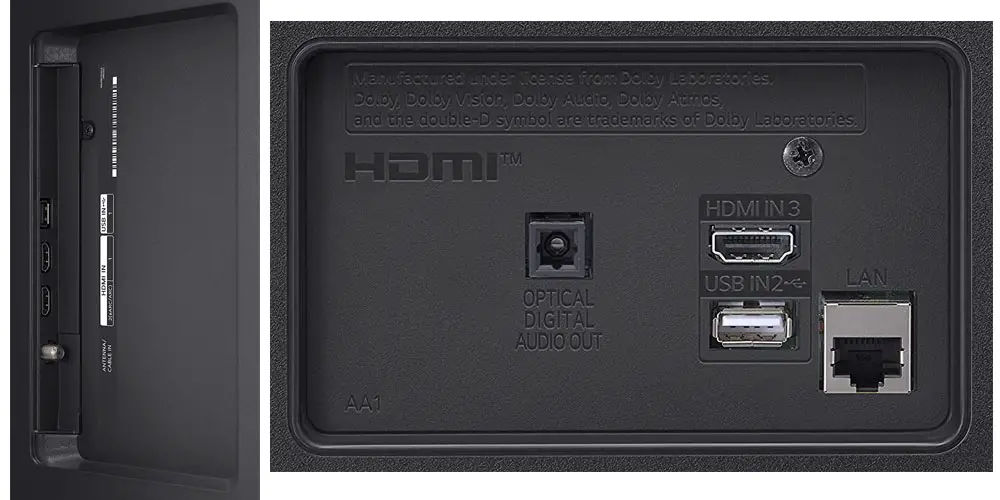
Starting from the side connectors first we find a couple of HDMI ports along with a single USB port for connecting external storage or other streaming devices and the usual antenna/cable input. For the back-facing ports we get one more HDMI input, another USB port, a digital optical audio output and an Ethernet port.
Judging by what we got here the UP8000 seems to be very similar to the UN7300 but with one glaring omission. There is no component input this year and this is something we have observed recently in our LG C1 review also where this one was missing its composite port from last year. As we said before LG is on a mission to take out all the analog ports from its products and it seems that so far many of their 2021 releases follow the same trend.
Also all UHD models have only HDMI 2.0 ports so if you were hoping for some HDMI 2.1 goodness don’t be as you will have to look for at least a mid-tier NanoCell to find the first HDMI 2.1 port available. At least we get eARC which the UN7300 did not have.
Lastly we should mention that the UP8000 comes with built-in WiFi (802.11ac) while we are pleased to see also support for the newer Bluetooth 5.0 which ensures better and more stable connections.
OS, Apps and Features
One of the biggest software changes this year has to be the new webOS 6.0 which looks very different to what we were used to the last few years. And from what we see the UP8000 features exactly the same smart platform we recently experienced in our LG C1 review so our observations in this part of our review will be similar and make appropriate changes wherever we deem necessary.
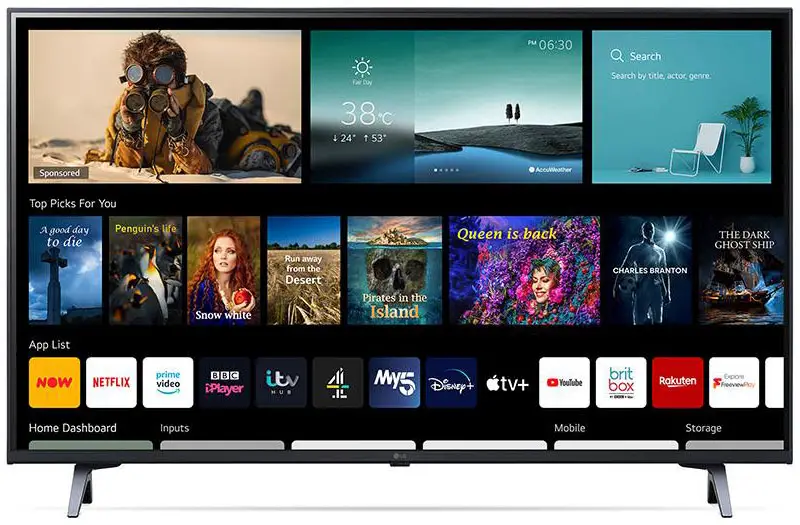
You see, up until last year webOS was using a single row of tiles on the lower part of the screen where everything was grouped together. Now in webOS 6.0 this has changed as the UI is taking up the whole screen and provide you with far more visual information than any of the previous versions ever did. We do get that some may prefer the old design that could still allow you to watch what was on screen but this is completely a personal preference.
The new webOS reminded us a bit of what Google TV is doing. It seems that smart TV platforms opt for a more personalized experience and as such the new webOS 6.0 tries to provide you with options that are tailored for your viewing habits. As such there are personalized ads, recommendations based on your viewing patterns both for streaming services and broadcasting channels and even shopping suggestions.
When you first look at the new design you will certainly feel like it’s a cluttered mess but if you spend a few minutes with it most of its architecture will dig in and you will get the hang of it fairly fast. By pressing the Home button the main webOS page opens where you still get a single row of your apps on the bottom that you can re-arrange any way you want.
On the top you get three big tiles for sponsored content, weather and time along with search. Below a single row with recommendations depending what LG’s algorithm believes you would like to watch. Under the apps row there are many more options to choose from like the Home Dashboard, broadcasting channels, shopping recommendations, Sports Alerts messages and much more.
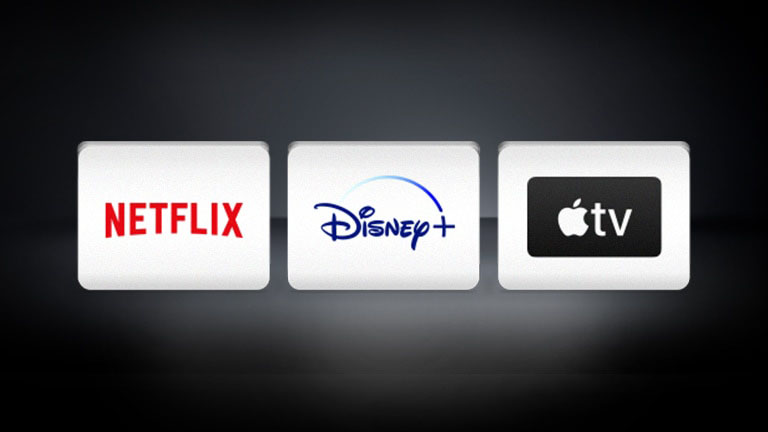
Overall we can say that we like what LG did with the new webOS 6.0. It feels fresh although a bit more cluttered for those not interested in so much information the new UI provides. Also if you are used in the UI of the previous years it will certainly take some time to find your bearings.
One thing that hasn’t changed in the new 2021 version of webOS is app support and as such you will find all the apps you may need with more available from the online store for downloading. All the big players are present with Netflix, Youtube, Amazon Prime, HBO, Vudu, Hulu, Google Play Movies, Disney+ and Apple TV+ just to name a few of the most notable ones.
Other available apps include Apple Airplay 2 and Apple Homekit. With Airplay 2 you can stream content from other Apple devices on your TV while HomeKit lets you control certain aspects of the TV through your mobile device.
One interesting feature that makes a comeback this year is Sports Alert. You can set your favorite team on the TV and the UP8000 will inform you when a match will be shown and in which channel while can also give you score updates and the likes. The Sports Alert feature seems to be working with the internal tuner and it gives you the ability to choose from a wide range of teams and sports. Obviously it still doesn’t include every sport and every team out there but there are plenty to choose from the list available.
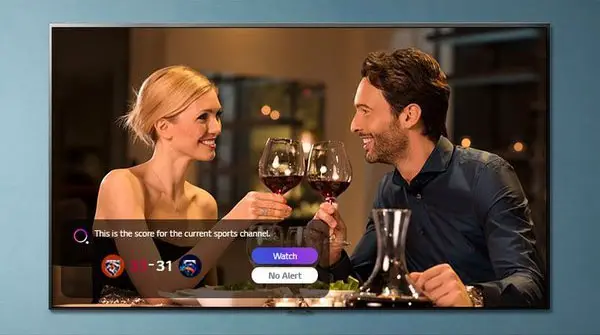
And since we are talking about a smart TV platform we could not go by without mentioning voice control functionality. LG has included not only their own ThinQ AI that you can use to search for various information but also the two most used voice control platforms including Amazon Alexa and Google Assistant. By using the Magic Remotes built-in microphone you can issue your commands like search for a specific TV show or control your TVs volume and change channels.
There is also mobile app support if you prefer that instead of using the included remote. LG is using their ThinQ app that is supported both by Android and iOS devices and with it you can issue some basic commands to your TV.
For another year we find what LG calls Home Dashboard which is a nice little feature that lets you have an overall look at all the connections of the TV. Although not much have changed here Home Dashboard has now been fully intergraded into the webOS 6.0 Home screen making its access faster than before.
Before closing we need to mention about the new Game optimizer feature that was added this year and with it you can check specific settings during gaming including fps, image options, colors, sound and many more. It is in a way similar to what Samsung has done and it shows that manufacturers have put a lot of effort to offer more practicality and accessibility to gamers which was to be expected with the new generation of consoles now out in the market.
Overall the UP8000 seems to get the full webOS treatment. With version 6.0 giving the user a major visual overhaul it can take some time to get used to it but in our opinion is a step to the right direction and it’s good to see that the UP8000 get full support of it.

Final Thoughts
The UHD TV series were always the most cost friendly series LG had to offer and for one more year it is here to remind us that no matter how much technology progresses there will always be those that look for a low cost solution for their entertainment. But the arrival of the QNED series meant that certain models would not follow the natural progression from what we saw last year.
The UP8000 is not a clear evolution of either the UN8500 or the UN7300. It shares certain features with both, it has similar performance in certain aspects with both of them but also surprisingly fared worse than both in some others.
What we liked on this one was the very sharp 4K images it could display, its good up-scaling capabilities, nice viewing angles and extremely low input lag. The inclusion of ALLM will certainly benefit gamers while the Filmmaker and HGiG modes available are a plus but ultimately will not do much with the TV’s limited image performance. Lastly the new webOS 6.0 is great even if it needs some time to get your bearings while the redesigned Magic Remote feels fresh even if functionality remains the same.
On the other hand the most obvious problems is no other than the brightness as the TV cannot display HDR as it should. Also it lacks wide color gamut while contrast was not good at all with blacks displaying mostly as greys. The TV is missing Dolby Vision but this shouldn’t be a huge omission with the unit’s limited capabilities while motion performance was ok but nothing crazy to talk about. Lastly there are no HDMI 2.1 ports available here so this could trouble a few interested gamers.
Closing what we can say about the LG UP8000 is that it can be a decent purchase if you are looking for a low cost TV that is intended for casual or gaming use. It’s capabilities in terms of picture quality are limited but if you don’t have high expectations, and you really shouldn’t at this price range, then it can offer you plenty of entertainment.
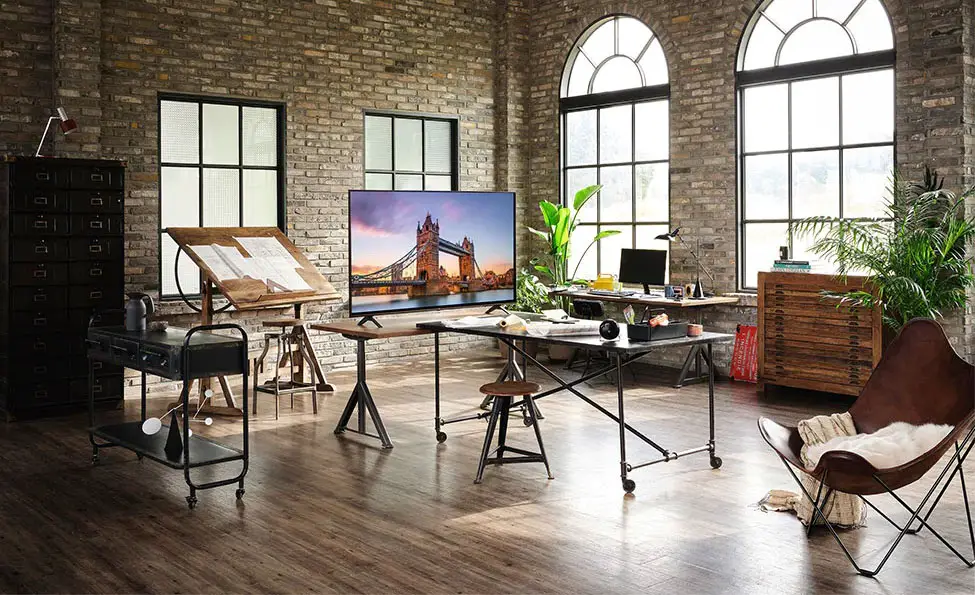
For more reviews you can check our dedicated 4K LED LCD TV reviews list or even look at our Product Reviews Table where you can find the brand and specific product you are looking for.
Cheapest Places to Buy :
*We are a reader-supported website. When you buy through links on our site, we may earn a small affiliate commission at no extra cost to you. Home Media Entertainment does not accept money for reviews.*
I have been in the market for a new TV, as I have recently moved and have a game room to furnish. I stumbled upon your review of the LG UP8000 and I have to say that overall it looks like a good low cost TV. I would love to have HDMI 2.1 to take advantage of the PS5 but I guess in this price I shouldn’t expect as such.
Indeed in this price HDMI 2.1 is not possible. But for gaming the UP8000 is definitely a good one even without some more advanced game centric features.
I am looking for a TV mostly for gaming but also for some movies. I am not looking into anything expensive so I saw the UP8000 you reviewed here and was thinking about it. Is its HDR as bad as you say it is? I don’t have a lot of expectations but at least I want to get some basic quality.
Hello Gabriel. Well, it depends really on what you consider basic quality. In general the UP8000 is not very good as its brightness is mediocre and its color coverage is not enough to be considered having wide color gamut. But if you don’t have high expectations then maybe you will be satisfied by its image quality. If you are not sure from the review then the best course of action is always going to a local store and judge for yourself.
But for a low cost gaming TV this one is definitely good. It may not have HDMI 2.1 but its low input lag offers a very pleasant gaming time.
Mr Kampourogiannis, truly hope you are doing well. Well done for your really detailed analysis. I was wondering if there is a difference between this model and the UP81003LR apart from its stand. Thank you.
Hello Antoni. I haven’t seen the UP8100 myself but by looking at the specs and everything I would have to say yes. The stand is the only difference between these two.